An ATV winch is a lifesaver when you’re stuck in mud or hauling heavy loads. But when encountered with an ATV winch not working – due to motor failure, not pulling, remote not working, and other electrical or mechanical issues – it can be frustrating.
Don’t worry.
This guide walks you through common winch troubleshooting steps, simple fixes, and maintenance tips to keep your winch running smoothly.
Before jumping into repairs, it helps to understand what’s going on inside your winch. A quick look at how it works will make troubleshooting much easier.
Read: Choosing an ATV Winch For Your Need
Jump To Contents
- Understanding ATV Winches
- Common Reasons Why Your ATV Winch is Not Working
- ATV Winch Troubleshooting: Step-by-Step Guide
- How to Maintain an ATV Winch: Preventative Maintenance Tips
- How to Enhance ATV Winch Performance
- When to Seek Professional ATV Winch Repair Service?
- Key Takeaways: Fixing a Non-Working ATV Winch
- Fix an ATV Winch, Not Working, Like an Expert
- FAQs on ATV Winch Problems
Understanding ATV Winches
Before diving into fixes, let’s understand how ATV winches function. Knowing the basics will help you troubleshoot issues more effectively.
How ATV Winches Work
ATV winches use an electric or hydraulic motor to spool a cable around a drum. When activated, the motor engages, pulling in or releasing the cable to move or recover your ATV when and in stranded or stuck off-road.
Power? It comes from your ATV’s battery, with a solenoid directing electricity to the motor.
Imagine you’re stuck in deep mud. When you activate the switch, the solenoid routes power from the ATV battery to the motor, which spins the drum and pulls the cable — steadily freeing your vehicle.
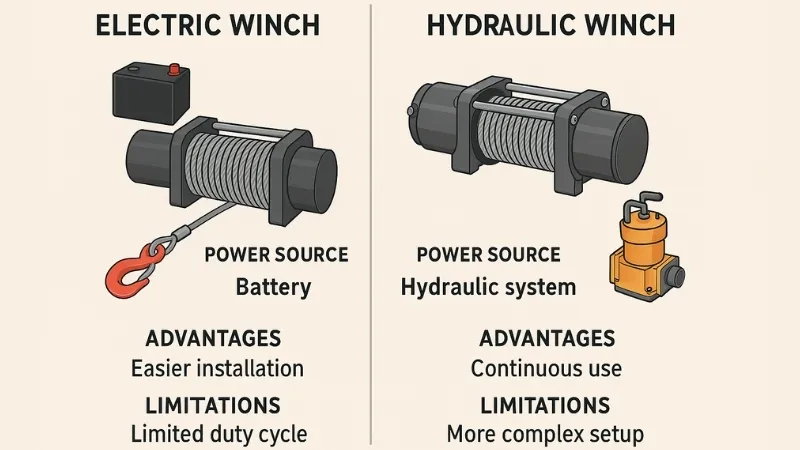
Read: Know Why Electric ATV Winch is Preferred by Off-Roaders
Types of ATV Winches
Not all winches are the same. The two main types are:
Electric Winches – Powered by the premium quality batteries meant for ATVs with winch. They are easy to install and work well for most riders but can drain the battery quickly under heavy use.
Hydraulic winches – Use the ATV’s power steering pump. These offer continuous operation without battery drain but require a compatible hydraulic system.
Read: Best ATV/UTV Winch Kits: Top 7 Off-road Winch Kits in 2025
Key Components
Understanding winch components helps pinpoint failures faster. The main parts include:
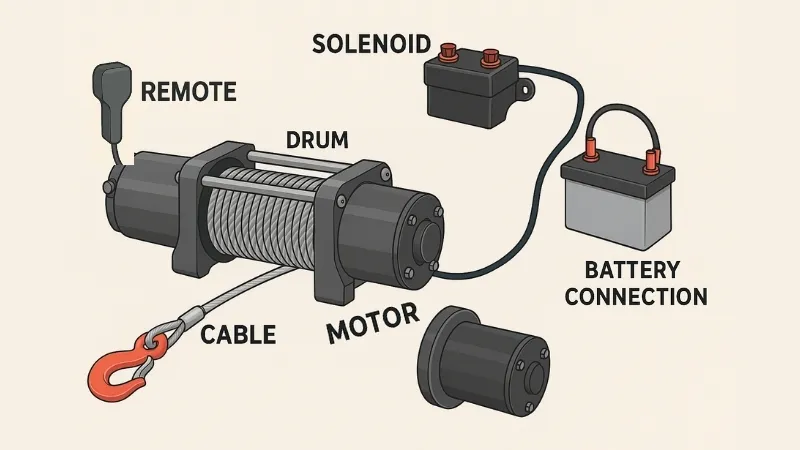
- Battery – Supplies power to the winch. A weak battery leads to poor performance or no operation.
- Solenoid – Acts as a switch, often called directing power from the battery to the motor.
- Switch/Remote – Controls the winch operation. A faulty remote means no response.
- Motor – The heart of the winch, responsible for pulling the cable in or letting it out.
- Wiring – Connects all components. Loose, frayed, or corroded wires can stop power from flowing properly.
With the inner winch workings covered, it’s time to dive into what might actually cause your winch to stop working.
Read: Wiring ATV Winch in 10 Simple Steps
Common Reasons Why Your ATV Winch is Not Working
A non-working winch could be due to electrical issues, mechanical failures, or user errors. Below are the most common causes and how they affect performance.
Electrical Issues
Electrical problems are a leading cause of winch failure. If your winch isn’t responding, start by checking these key areas:

- Dead or weak battery – Not enough power to run the winch. A weak battery may allow the solenoid to click but won’t have enough juice to pull a load. A weak battery or a dead one outliving its lifetime needs to be addressed. ATV winch not working in cold temperatures is a common phenomenon as extreme temperature affects battery performance. So, check for the charge level before winching.
- Faulty solenoid or relay – No clicking sound? It’s likely bad. A defective solenoid prevents power from reaching the motor, making the winch unresponsive.
- Damaged wiring or corrosion – Loose or rusty connections stop the current. Even minor corrosion on terminals can create resistance, limiting power flow.
Winch Motor Failure
If your winch powers on but doesn’t pull, the motor may be to blame. Here’s what to check:
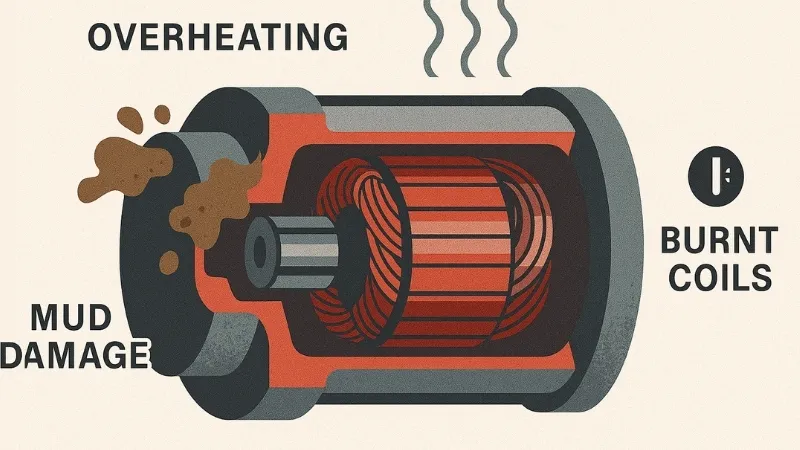
- Overheating – Excessive use can cause the motor to overheat and stop. Running the winch continuously for too long can trigger thermal overload protection.
- Water or mud damage – Moisture can short out the motor. ATV winches aren’t always waterproof. So, if your ATV doesn’t have a waterproof winch, water exposure can corrode internal parts.
- Burnt-out motor – If the winch is overloaded, the motor can fry. A burnt smell or complete failure to respond could indicate permanent damage.
Mechanical Failures
Mechanical issues usually involve the winch drum, gears, or clutch. These prevent smooth spooling and pulling action.
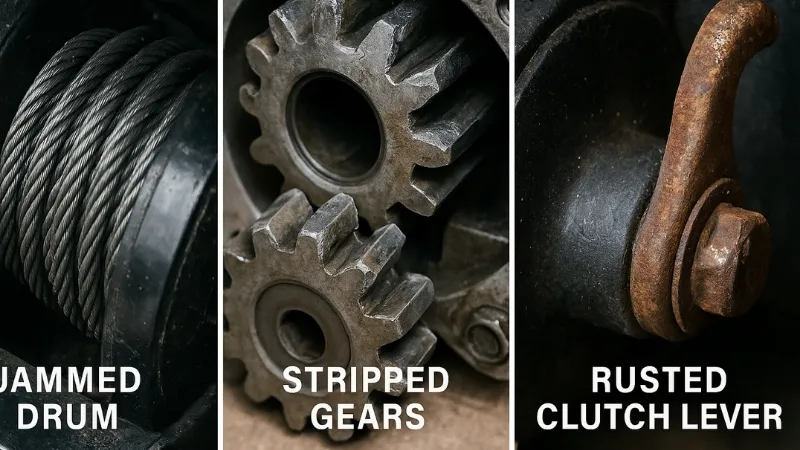
- Jammed drum – The winch drum isn’t turning properly. A misaligned cable or debris inside the drum can lock it up.
- Worn-out gears – Internal gears might be stripped. This happens over time due to heavy loads or insufficient lubrication.
- Free-spooling problems – The clutch is stuck or not engaging. If the free-spool lever is stiff or won’t move, it could be jammed with dirt or rust.
Remote or Switch Issues
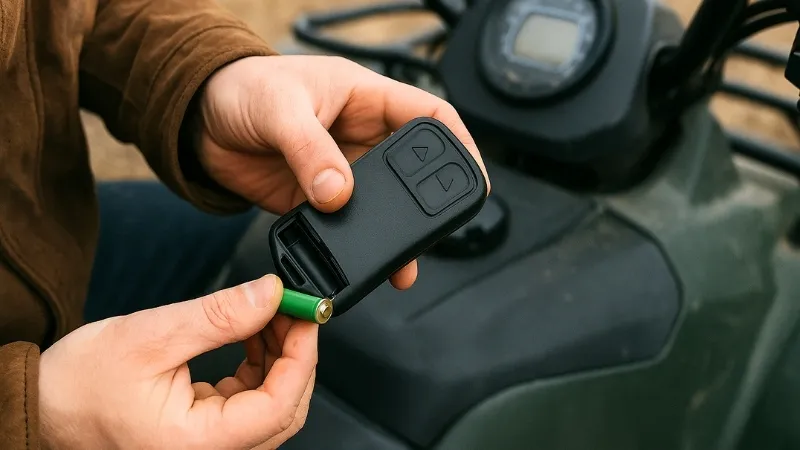
Your winch remote or switch is the interface between you and the winch. If it’s not working, your winch won’t activate.
- Remote not responding – Dead batteries or internal damage. If the remote works intermittently, it could be a signal issue.
- Wiring issues – Loose connections inside the switch. Sometimes, a simple reattachment of wires can restore function.
Load and Rope Problems
Winches are designed to handle specific loads, and any rope issues can disrupt performance.
- Overloaded winch – Pulling more weight than its capacity. Overloading can strain the motor and burn out internal components.
- Tangled or frayed rope – A twisted cable won’t spool properly. A kinked steel cable or frayed synthetic rope weakens pulling strength and can snap under stress.
Understanding the causes is half the battle. Now, let’s roll up our sleeves and apply some practical fixes to get your winch running again.
Read: Installing Winch on an ATV Successfully
ATV Winch Troubleshooting: Step-by-Step Guide
Got a winch not pulling or working at all? Let’s go through the key fixes.
Before performing any troubleshooting, make sure your ATV is parked securely, the ignition is off, and you’re wearing gloves to prevent electric shock or cable injury.
Check the Power Supply

Power issues are the first thing to rule out. Without enough voltage, your winch won’t work at all.
- Test your ATV battery with a multimeter that should read 12V or higher. A battery below 12V might cause weak performance. There may be two issues – weak/dead battery or battery running low in need of recharging.
- Corrosion buildup can block power flow and lead to inconsistent winch operation.
- Check fuses to any blown fuse that indicates an overload or short circuit.
Fix:
- Recharge a battery running low and revive battery if found dead
- Clean battery terminals and tighten loose connections.
- Replace winch fuse if found blown.
Test the Solenoid & Relay
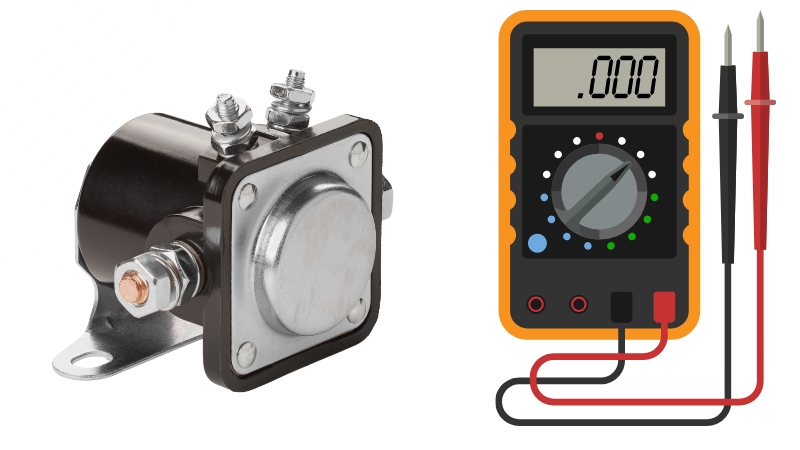
If your winch has power but won’t move, the solenoid or relay might be faulty. So, testing solenoids is inevitable.
- Listen for clicking sounds when activating the winch. No click usually means a failed solenoid.
- Bypass the solenoid with jumper cables to test if the winch motor still runs. If it does, you need a new solenoid.
Fix: A faulty winch solenoid replacement is the bet. A burned or stuck solenoid or relay won’t transfer power properly.
Inspect the Motor
Motor problems can prevent your winch from pulling under load.
- Smell burning? It is your winch motor not working or may be fried. Excessive use without breaks can cause burnout.
Fix:
- Tap it lightly with a hammer—sometimes stuck brushes loosen up. This is a quick test before replacing the motor.
- Disassemble and clean mud or debris inside. Dirt buildup can interfere with proper function.
Check the Winch Drum & Cable
If your drum or cable isn’t working properly, the winch won’t function efficiently.
- The winch won’t spool in for a seized drum, requiring lubrication or readjustment of it.
- Uneven winding can create knots and tangles.
- A weak cable can snap under stress, leading to dangerous situations.
Fix:
- Free up a stuck drum by manually turning it.
- Re-spool the cable neatly to prevent jams.
- Replace a frayed or damaged rope.
Fixing Remote or Switch Issues
A faulty control system can stop your winch from working.
- Weak remote batteries can cause intermittent operation.
- Inspect the switch wiring for damage. If the wires are frayed or disconnected, the winch won’t respond. Sometimes, the internal components wear out and need a swap.
Fix:
- Change the remote batteries.
- If necessary, replace the switch or remote.
Once you’ve fixed the problem, it’s worth learning about the preventative steps so it doesn’t happen again anytime soon.
Read: Finding the Right Fuse for ATV Winch
How to Maintain an ATV Winch: Preventative Maintenance Tips
With the troubleshooting and fixing covered, you can now apply it to whatever ATV winch brand or model you use. Now, you can fix issues with Polaris, Yamaha, Warn, KFI, Badland, or Honda ATV winch not working properly or totally.
Irrespective of the brands, a little upkeep goes a long way. Here’s how to prevent future ATV winch failures:
- Keep it clean – Wash off mud, sand, and debris after each use. Dirt buildup can cause malfunctions over time.
- Check cables and connections – Loose wires can cut power. Inspect connections before every ride.
- Lubricate moving parts – Use light oil to prevent rust. This keeps the drum and gears running smoothly.
- Don’t overload it – Stick to your winch’s weight limit. Exceeding capacity shortens lifespan and risks damage.
- Warm Water Rinse – If you ride in snowy or salty environments, rinse the winch with warm water after use to remove salt deposits that can accelerate corrosion.
Maintenance keeps your winch healthy — but if you want to push performance even further, a few smart upgrades can make a big difference.
How to Enhance ATV Winch Performance
Want to get more out of your ATV winch? Here are a few upgrades to improve efficiency and durability:
- Upgrading to a higher-capacity winch – A stronger winch can handle bigger loads with ease, reducing strain on the motor.
- Adding accessories like wireless remote controls – eliminates the hassle of wired connections, making operation more convenient.
- Installing protective covers for harsh environments – a winch cover shields the motor and electronics from mud, water, and debris, extending lifespan.
- Consider upgrading to a synthetic rope if you frequently operate in wet or sandy terrain — it’s lighter and safer under tension than steel.
Of course, not every issue can be fixed at home. Here’s when it makes sense to call in a professional instead of DIY-ing.
When to Seek Professional ATV Winch Repair Service?
If you’ve tried all these steps and your ATV winch is still not working, it might need professional repair. Consider help if:
- The motor won’t run despite a working solenoid. This could indicate internal damage.
- There’s internal gear damage. Stripped gears require professional replacement.
- Electrical fixes don’t restore power. If wiring repairs fail, it may need expert attention.
Key Takeaways: Fixing a Non-Working ATV Winch
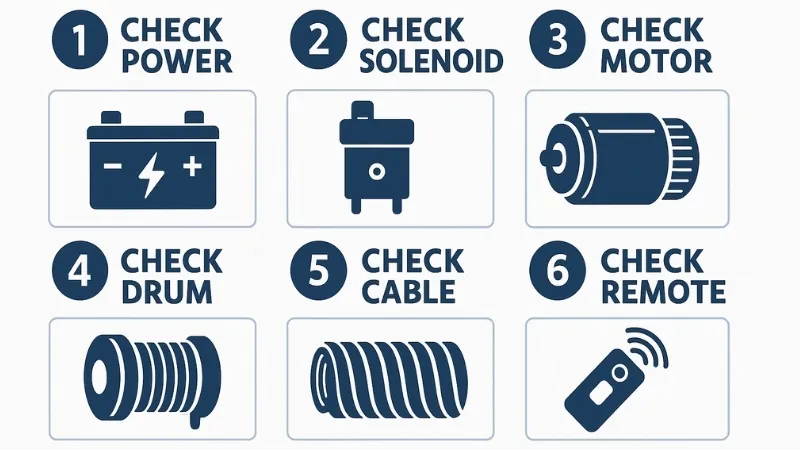
Your ATV winch is your off-road lifeline. With smart troubleshooting, regular cleaning, and proper usage, it will always be ready to pull you out of the mud or tackle any haul with confidence. Here you go with the summarised run-down of the key points of this long guide.
- Know How It Works First: An ATV winch uses your ATV’s battery to power a motor that spools a cable around a drum. Understanding this system helps identify what’s wrong faster.
- Electrical Failures Are Most Common: A weak or dead battery, faulty solenoid, or corroded wiring are frequent culprits when a winch won’t power up or pull.
- Motor Issues Often Follow Overuse: Overheating, water intrusion, or overloads can burn out the motor. Watch for a burnt smell or lack of response.
- Mechanical Problems Block Spooling: A jammed drum, worn gears, or a stiff clutch can prevent proper winch operation. Clean and lubricate regularly.
- Don’t Forget the Remote or Switch: Dead remote batteries, broken switches, or loose connections can mimic bigger problems. Always check controls first.
- Step-by-Step Fixes Work Best:
- Test battery voltage (should be 12V+).
- Listen for solenoid clicks.
- Inspect motor for damage or debris.
- Check drum and cable alignment.
- Replace remote batteries or faulty controls.
- Preventive Maintenance Is Key: Keep the winch clean, wires tight, parts lubricated, and never exceed the rated load. A few minutes of upkeep after every ride prevents most failures.
- Upgrade for Better Performance:
- Use a higher-capacity winch for heavy tasks.
- Add a wireless remote for ease of use.
- Protect it with a weather-resistant cover.
- Call in Professionals When Needed: If power and mechanical fixes fail, or if internal gears/motor damage are suspected, seek a professional technician.
- Regular Care = Long Life: Consistent inspection, cleaning, and smart use ensure your winch will always be ready when you’re stuck or hauling.
Fix an ATV Winch, Not Working, Like an Expert
Your ATV winch is your best friend when off-roading, so keeping it in top shape is essential. Now you know how to troubleshoot and fix common winch motor failures, winch remote not working issues, and winch troubleshooting steps.
You’re ready to tackle any problem head-on in make or model of ATV be it for Polaris, Superwinch, Champion, or Warn ATV winch troubleshooting and fixing.
Knowing how to maintain an ATV winch is also essential to keep it super functional.
Got questions? Drop them in the comments and let’s talk.
FAQs on ATV Winch Problems
Why is my winch clicking but not working?
Likely a bad solenoid or weak battery. A winch not working just clicking sound without movement often means the motor isn’t getting enough power. Double-check the battery charge and solenoid wiring to ensure full power delivery.
Can I fix a broken winch rope myself?
Yes, you can. Just replace it with a new synthetic rope or steel cable. Make sure it’s rated for your winch capacity. Ensure the new rope is properly spooled under light tension to prevent future tangles or snapping.
How do I prevent my winch from overheating?
Give it cool-down breaks and avoid constant heavy loads. Overuse can lead to overheating and long-term damage. Short bursts of operation help preserve motor health and extend its overall lifespan.
How do I test an ATV winch solenoid?
To test the solenoid, use a multimeter to check for continuity between terminals while activating the winch. If there’s no response or clicking, the solenoid may be faulty and need replacement. Learn from a comprehensive guide on testing ATV winch solenoid like an expert.
Why is my winch drum not turning?
A jammed drum can be caused by a misaligned cable, dirt buildup, or mechanical failure. Try manually rotating the drum, cleaning debris, and ensuring the clutch is engaged. Try manually rotating it after cleaning and ensure the clutch lever is fully engaged before retrying.
How do I fix a jammed winch cable?
Carefully unwind the cable, inspect for tangles or knots, and re-spool it evenly under light tension. If the cable is damaged, replace it to prevent further issues. Apply light tension while re-spooling to keep the layers tight and evenly distributed on the drum.
How do I keep my ATV winch from failing?
Regularly inspect and clean the winch, keep electrical connections corrosion-free, lubricate moving parts, and avoid overloading beyond its rated capacity. Also, lubricate gears and electrical contacts periodically to maintain smooth operation.
Relevant Reads include: